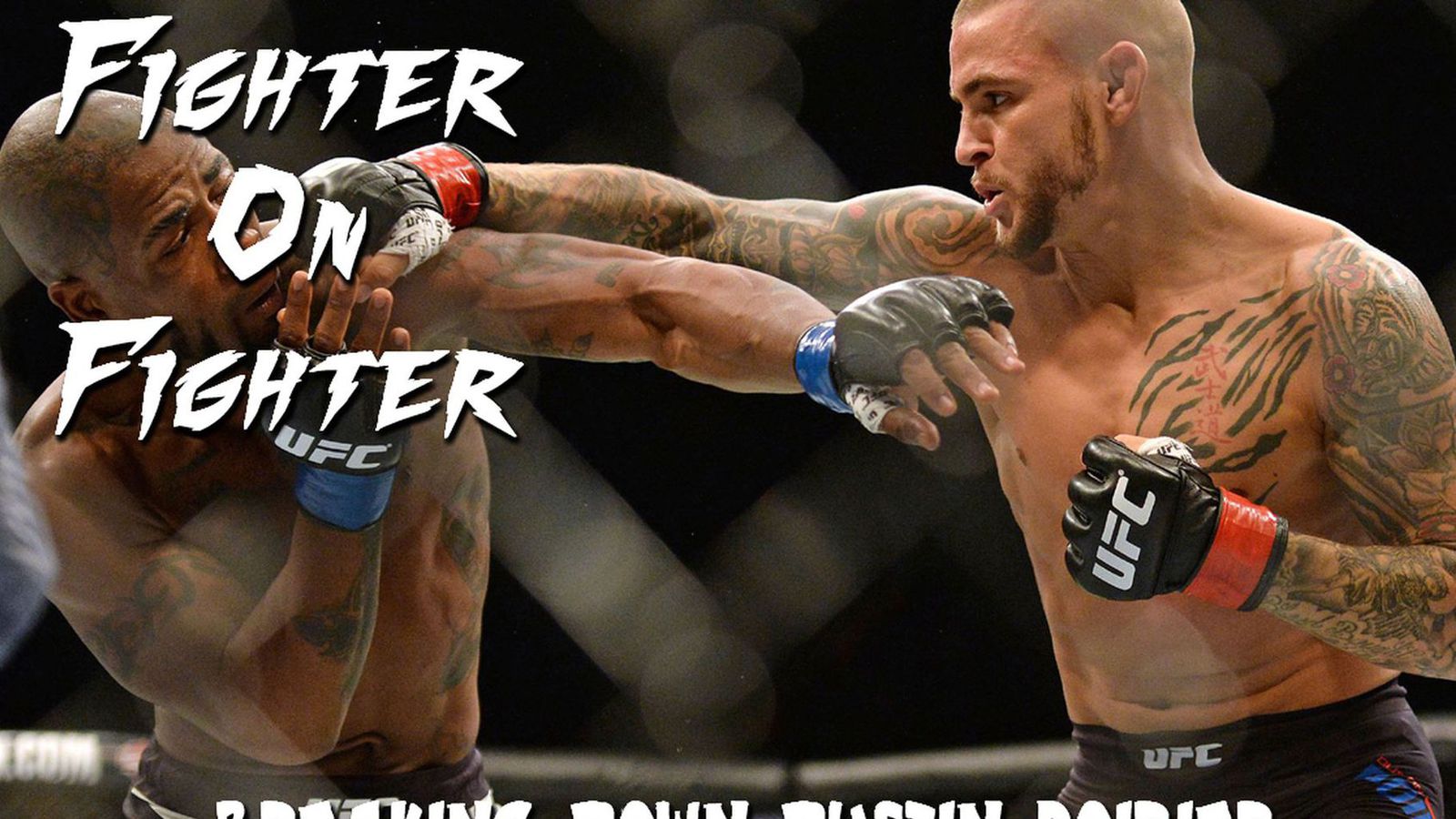Knockout artist, Dustin Poirier, will square off with Sambo specialist, Khabib Nurmagomedov, this Saturday (Sept. 7, 2019) at UFC 242 from inside The Arena in Abu Dhabi, United Arab Emirates.
After Michael Johnson knocked out Poirier in 2016, “The Diamond” changed. He’d always been tough, well-rounded and powerful, but that loss seemed to really inspire Poirier to focus on developing his boxing. Poirier’s hands improved quickly, and the rest of the pieces of his game clicked as a result. Poirier surged up the Lightweight ladder, knocking off former champions left and right. His five-round war with Max Holloway solidified it: Poirier is a deserving champion. However, there is another great task ahead of him, as Poirier will attempt to unify the titles and hand Nurmagomedov his first career loss.
Let’s take a closer look at his skill set:
Striking
God damn, Poirier hits hard. He finished fighters at Featherweight, but Poirier knocks foes out with a rare consistency at 155 pounds. His punching power cannot be overstated: Poirier fights very tough men yet consistently gets them to back off or curl up along the fence due largely to how ferocious his punches are.
Despite his punching power, Poirier now does a nice job of remaining within his stance and setting up the knockout with combinations. For the most part, Poirier fights out of the Southpaw stance. Occupying his opponent’s lead hand with his own (assuming he’s facing a right-handed opponent), the leftie will shoot out a sharp cross into his opponent’s chin. While he can throw the punch from a measured stance, he’ll also step deeper into the punch, allowing him to more easily follow up with a crushing right hook (GIF).
In general, Poirier does well leading with the left hand (GIF), which is the technique covered in this week’s breakdown video.
In Poirier’s bout with Joe Duffy, he was forced to use his shifts into the Orthodox stance in another way. The Irishman was touching him up a bit, so Poirier switched it up and made the fight ugly as possible, thriving in close exchanges. A couple times, Poirier would lunge with his left cross and use it to latch onto a single collar-tie with that same hand. From there, he would attack with right hooks and uppercuts. In addition, the aforementioned left hand roll into Orthodox and jabs helped him back Duffy into the fence.
Despite the emphasis on leading with the left, Poirier actually jabs very well for a Southpaw. Against Eddie Alvarez in particular, Poirier did a great job of hand-fighting into the jab, snapping Alvarez’s head back with great consistency.
It’s become a bit less of a focus, but Poirier is a solid kicker as well. Against Duffy’s long frame and jab, Poirier made great use of low kicks. Attacking both inside and outside of his opponent’s leg, Poirier slowed him down and was able to land quality follow up punches. In other bouts, Poirier has been more reliant on the standard left roundhouse to the body. Since his left hand is such a threat, the left kick is a great weapon that often slips through his opponent’s defenses and lands clean (GIF). Opposite Max Holloway, Poirier did well to set up his right low kick by showing the major threat that is his overhand left (GIF).
In addition, Poirier was known early in his UFC career for his dangerous front kick. He doesn’t rely on it so often anymore, but Poirier found great success in walking his opponent down and pushing them into the fence with a punt to the chest (GIF).
In his recent bouts with Alvarez and Gaethje, Poirier did not look to force the issue — in part because his opponents were quite happy to trade. Instead, Poirier was more measured and rangy, looking to time his long punches and kicks from the edge of his kickboxing distance. The left cross-left kick combo worked well against Alvarez at distance, whereas Poirier was forced by Gaethje’s aggression to counter more often. His dedication to range and counter punching ultimately decided the fight, as Poirier repeatedly landed a counter cross while Gaethje attacked his lead leg.
Eventually, one such cross put Gaethje on wobbly legs and ended the fight.
Wrestling
Early in his career, Poirier was not really known as a knockout artist. Instead, the former high school wrestler would physically overpower his opponents and submit them on the mat.
Poirier does much of his best wrestling in the clinch, as he definitely leans on strength more than speed. Once he commits to taking the fight to the mat, Poirier does a very nice job mixing together different trips and foot sweeps. Locking his hands from either the over-under or double underhook position to create a tight body lock, Poirier will look to land an outside trip. If that fails and his opponent is off-balance, Poirier will attempt to spin him with a quick foot sweep.
In addition, Poirier always has the option to pressure into the body lock and force his foe to the mat.
Poirier also looks to level change into the double leg takedown fairly often. There’s nothing to complicated here, as Poirier will either look to blast his opponent off his feet with a reactive shot or wait until his foe’s back is to the fence. Either way, Poirier’s shot and finish are powerful enough to get most men to the mat, and his punches do a nice job of keeping his foe distracted. Opposite Duffy, Poirier repeatedly ducked into the shot following his cross, which allowed him to get in on his opponent’s hips well. This worked well opposite Pettis too, as Poirier was able to get in on his hips fairly often with the double leg.
Defensively, Poirier has historically been a very solid. He has a strong sprawl and defends himself particularly well when pressed into the fence, using underhooks and collar ties to force his opponent’s posture up. Once he’s able to work back into the clinch, he’s usually safe from takedowns.
Of course, Khabib Nurmagomedov is a different type of wrestling threat from any he’s faced in the past.
Brazilian Jiu-Jitsu
Poirier began his career training under Brazilian jiu-jitsu black belt Tim Credeur and moved to another submission-heavy camp in American Top Team way back in 2012. Currently, Poirier holds a black belt and has finished seven of his opponents via submission.
On the mat, Poirier is best known for his d’arce choke — he’s in second place for the most in UFC history — which make full use of his long arms.
There are two main positions from which the d’arce can commonly be hit and Poirier has successfully used both of them, though it’s been many years now. Years ago, Poirier finished off Jonathon Brookins after sprawling on his opponent’s double leg. With Brookins’ arms extended and reaching for his legs, Poirier had plenty of space to slip his outside arm around Brookin’s head and neck.
Once the hold was locked in, Poirier sat his hips out and circled toward Brookins (GIF). This put even more pressure on the choke, which works the same way as a triangle choke, cutting off both sides of the carotid artery.
Just a few fights earlier, Poirier locked in the d’arce choke from top position in half guard. The d’arce is an excellent counter to the underhook, and using the underhook to stand up from half guard is one of the most common techniques in the sport. Opposite Pablo Garza, Poirier quickly locked in the d’arce from half guard. This time, he didn’t bother sitting out, choosing to flatten out, lay his weight on Garza, and squeeze (GIF).
Furthermore, Poirier is known to hunt for the arm bar from top position. In Max Holloway’s debut, Poirier nearly disarmed the young Hawaiian. However, the “Blessed” fighter toughed it out and rolled into top position, forcing Poirier to change his attack. Rather than abandon the arm bar entirely, Poirier transitioned into a triangle choke, rolled Holloway over, and cranked on his arm once more (GIF).
In his bout with Pettis, Poirier was not able to finish the fight via a usual submission, but he nonetheless showed off his excellent top game. He braved Pettis’ genuinely dangerous guard and dropped big punches, and he used Pettis’ offense against him to gain dominant positions. Whenever “Showtime” opened up his guard to attack, Poirier would immediately look to throw the legs by. Once aided by sweat and blood, Poirier was able to more consistently pass and secure the back mount, which eventually finished the former champion.
He nearly got triangled in the process of all this top position work, but he was able to escape multiple times thanks to good posture, the aforementioned slipperiness in play, and the round clock running out at one point.
Conclusion
Poirier is being overlooked. He may be unable to talk the game of Conor McGregor or have the years of build up behind his shot like Tony Ferguson, but Poirier is without a doubt the most difficult match up Khabib Nurmagomedov has faced yet. “The Diamond” is gritty, powerful and extremely experienced — a recipe for success against just about anyone.
Andrew Richardson, a Brazilian jiu-jitsu brown belt, is a professional fighter who trains at Team Alpha Male in Sacramento, California. In addition to learning alongside world-class talent, Andrew has scouted opponents and developed winning strategies for several of the sport’s most elite fighters.
















